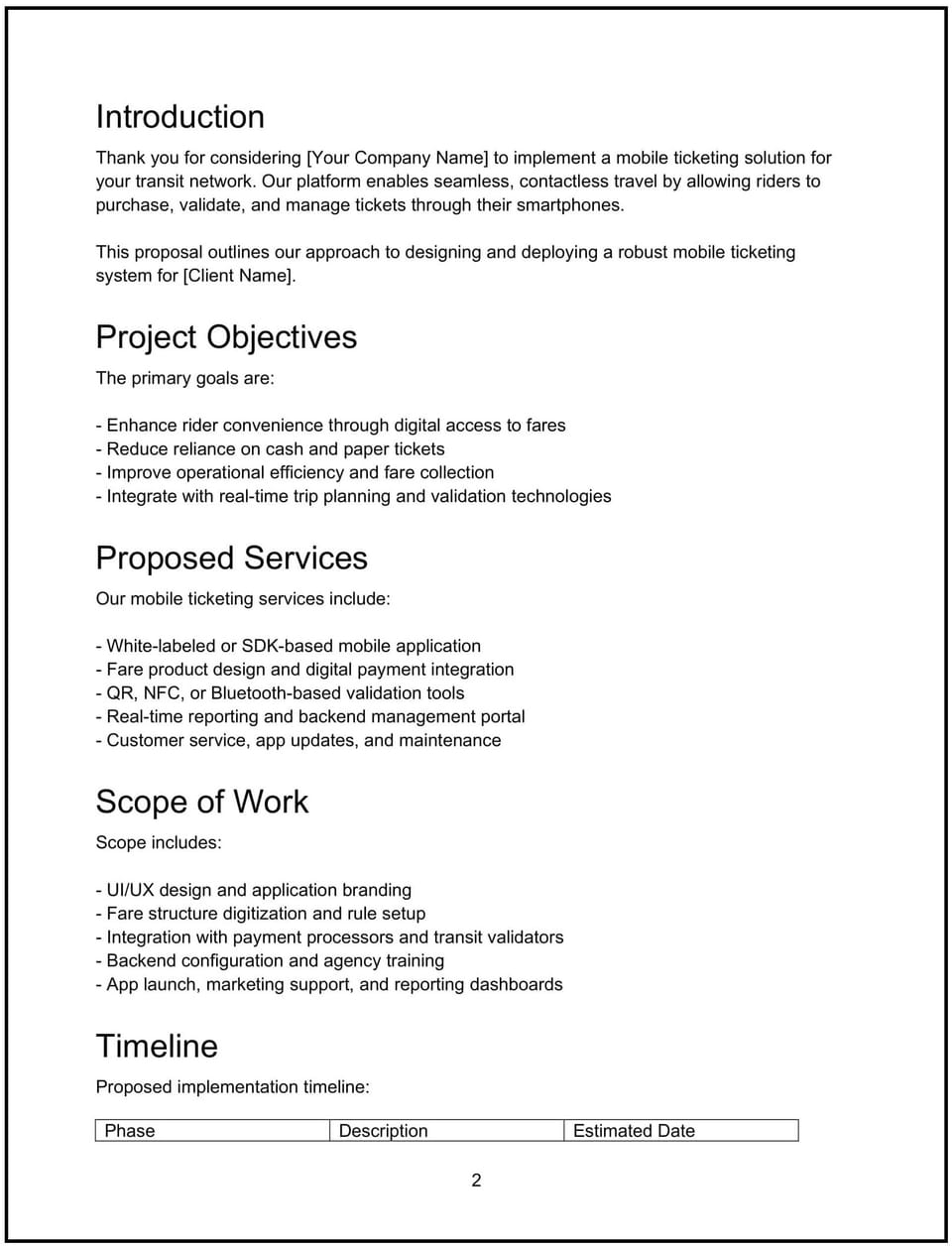Public transit mobile ticketing proposal: Free template

Customize this free public transit mobile ticketing proposal with Cobrief
Open this free public transit mobile ticketing proposal in Cobrief and start editing it instantly using AI. You can adjust the tone, structure, and content based on your offer, the transit agency’s needs, and user expectations. You can also use AI to review your draft — spot gaps, tighten language, and improve clarity before sending.
Once you're done, send, download, or save the proposal in one click — no formatting or setup required.
This template is fully customizable and built for real-world use — ideal for pitching mobile ticketing system design, development, and deployment for public transit agencies. Whether you’re creating proposals regularly or occasionally, this version gives you a structured head start and removes the guesswork.
What is a public transit mobile ticketing proposal?
A public transit mobile ticketing proposal outlines a plan to develop and implement a mobile platform that enables passengers to purchase, store, and validate transit tickets using smartphones. It details your approach to app development, payment integration, security, and user experience.
Typically shared after discovery meetings or technical assessments, this proposal helps align stakeholders on scope, timeline, technical requirements, and budget.
A good public transit mobile ticketing proposal helps you:
- Define system features such as ticket purchasing, validation, and fare management.
- Communicate integration with existing transit infrastructure and payment gateways.
- Set phased implementation timelines with testing and launch milestones.
- Build confidence through user support plans and security measures.
Use this proposal when you want to present a comprehensive, user-friendly mobile ticketing solution.
Why use Cobrief to edit your proposal
Cobrief simplifies proposal creation with AI-powered tools:
- Edit fully in-browser — no uploads or formatting hassles.
- Use AI to rewrite sections for clarity, tone, and professionalism.
- Run AI reviews to detect unclear language or missing content.
- Accept AI suggestions individually or all at once.
- Export or share polished PDFs or DOCX files instantly.
When to use this proposal
This public transit mobile ticketing proposal fits scenarios like:
- Deploying new mobile ticketing apps for buses, trains, or light rail.
- Integrating with existing fare collection and validation systems.
- Enhancing user experience with digital wallets and contactless payments.
- Supporting real-time ticketing data and analytics.
- Planning user training, support, and feedback mechanisms.
Use this proposal when a detailed, customer-focused ticketing system plan is needed.
What to include in a public transit mobile ticketing proposal
Include these clear sections:
- Executive summary: Overview of transit agency goals and proposed ticketing solution.
- System features: Define ticket types, purchasing flows, validation methods, and account management.
- Technical integration: Describe backend connections, payment processing, and security protocols.
- Implementation roadmap: Phased development, testing, pilot, and rollout plans.
- User support and training: Outline helpdesk services, tutorials, and feedback channels.
- Budget and pricing: Transparent cost estimates covering development, licensing, and maintenance.
- Terms and conditions: Include compliance, privacy, and liability details.
- Next steps: Clear call to action — approve, schedule kickoff, or discuss specifics.
How to write an effective public transit mobile ticketing proposal
Write with clarity, user focus, and technical precision:
- Lead with passenger benefits: Emphasize convenience, speed, and security improvements.
- Avoid jargon: Explain technical components in accessible language.
- Be specific about features: Detail ticket options, payment methods, and validation processes.
- Highlight integration: Show how the system works seamlessly with existing infrastructure.
- Use phased timelines: Manage expectations with clear milestones.
- Close with a confident CTA: End with one clear next step to maintain momentum.
Frequently asked questions (FAQs)
How can I tailor this proposal quickly for different transit modes?
Adjust ticket types, validation technology, and integration points to suit buses, trains, or ferries.
What’s the best way to explain payment security?
Focus on encryption, tokenization, and compliance with standards like PCI DSS.
How should I present user support services?
Include multiple channels such as in-app help, call centers, and FAQs.
How do I address scalability concerns?
Highlight cloud infrastructure and modular design enabling growth.
Can I collaborate with transit operators and developers during drafting?
Yes — use Cobrief’s collaboration and version control tools.
This article contains general legal information and does not contain legal advice. Cobrief is not a law firm or a substitute for an attorney or law firm. The law is complex and changes often. For legal advice, please ask a lawyer.